Pingchuan Ma
TopoGaussian: Inferring Internal Topology Structures from Visual Clues
Mar 16, 2025Abstract:We present TopoGaussian, a holistic, particle-based pipeline for inferring the interior structure of an opaque object from easily accessible photos and videos as input. Traditional mesh-based approaches require tedious and error-prone mesh filling and fixing process, while typically output rough boundary surface. Our pipeline combines Gaussian Splatting with a novel, versatile particle-based differentiable simulator that simultaneously accommodates constitutive model, actuator, and collision, without interference with mesh. Based on the gradients from this simulator, we provide flexible choice of topology representation for optimization, including particle, neural implicit surface, and quadratic surface. The resultant pipeline takes easily accessible photos and videos as input and outputs the topology that matches the physical characteristics of the input. We demonstrate the efficacy of our pipeline on a synthetic dataset and four real-world tasks with 3D-printed prototypes. Compared with existing mesh-based method, our pipeline is 5.26x faster on average with improved shape quality. These results highlight the potential of our pipeline in 3D vision, soft robotics, and manufacturing applications.
MAPS: Multi-Fidelity AI-Augmented Photonic Simulation and Inverse Design Infrastructure
Mar 02, 2025



Abstract:Inverse design has emerged as a transformative approach for photonic device optimization, enabling the exploration of high-dimensional, non-intuitive design spaces to create ultra-compact devices and advance photonic integrated circuits (PICs) in computing and interconnects. However, practical challenges, such as suboptimal device performance, limited manufacturability, high sensitivity to variations, computational inefficiency, and lack of interpretability, have hindered its adoption in commercial hardware. Recent advancements in AI-assisted photonic simulation and design offer transformative potential, accelerating simulations and design generation by orders of magnitude over traditional numerical methods. Despite these breakthroughs, the lack of an open-source, standardized infrastructure and evaluation benchmark limits accessibility and cross-disciplinary collaboration. To address this, we introduce MAPS, a multi-fidelity AI-augmented photonic simulation and inverse design infrastructure designed to bridge this gap. MAPS features three synergistic components: (1) MAPS-Data: A dataset acquisition framework for generating multi-fidelity, richly labeled devices, providing high-quality data for AI-for-optics research. (2) MAPS-Train: A flexible AI-for-photonics training framework offering a hierarchical data loading pipeline, customizable model construction, support for data- and physics-driven losses, and comprehensive evaluations. (3) MAPS-InvDes: An advanced adjoint inverse design toolkit that abstracts complex physics but exposes flexible optimization steps, integrates pre-trained AI models, and incorporates fabrication variation models. This infrastructure MAPS provides a unified, open-source platform for developing, benchmarking, and advancing AI-assisted photonic design workflows, accelerating innovation in photonic hardware optimization and scientific machine learning.
Does VLM Classification Benefit from LLM Description Semantics?
Dec 16, 2024



Abstract:Accurately describing images via text is a foundation of explainable AI. Vision-Language Models (VLMs) like CLIP have recently addressed this by aligning images and texts in a shared embedding space, expressing semantic similarities between vision and language embeddings. VLM classification can be improved with descriptions generated by Large Language Models (LLMs). However, it is difficult to determine the contribution of actual description semantics, as the performance gain may also stem from a semantic-agnostic ensembling effect. Considering this, we ask how to distinguish the actual discriminative power of descriptions from performance boosts that potentially rely on an ensembling effect. To study this, we propose an alternative evaluation scenario that shows a characteristic behavior if the used descriptions have discriminative power. Furthermore, we propose a training-free method to select discriminative descriptions that work independently of classname ensembling effects. The training-free method works in the following way: A test image has a local CLIP label neighborhood, i.e., its top-$k$ label predictions. Then, w.r.t. to a small selection set, we extract descriptions that distinguish each class well in the local neighborhood. Using the selected descriptions, we demonstrate improved classification accuracy across seven datasets and provide in-depth analysis and insights into the explainability of description-based image classification by VLMs.
ROICtrl: Boosting Instance Control for Visual Generation
Nov 27, 2024



Abstract:Natural language often struggles to accurately associate positional and attribute information with multiple instances, which limits current text-based visual generation models to simpler compositions featuring only a few dominant instances. To address this limitation, this work enhances diffusion models by introducing regional instance control, where each instance is governed by a bounding box paired with a free-form caption. Previous methods in this area typically rely on implicit position encoding or explicit attention masks to separate regions of interest (ROIs), resulting in either inaccurate coordinate injection or large computational overhead. Inspired by ROI-Align in object detection, we introduce a complementary operation called ROI-Unpool. Together, ROI-Align and ROI-Unpool enable explicit, efficient, and accurate ROI manipulation on high-resolution feature maps for visual generation. Building on ROI-Unpool, we propose ROICtrl, an adapter for pretrained diffusion models that enables precise regional instance control. ROICtrl is compatible with community-finetuned diffusion models, as well as with existing spatial-based add-ons (\eg, ControlNet, T2I-Adapter) and embedding-based add-ons (\eg, IP-Adapter, ED-LoRA), extending their applications to multi-instance generation. Experiments show that ROICtrl achieves superior performance in regional instance control while significantly reducing computational costs.
Learning Object Properties Using Robot Proprioception via Differentiable Robot-Object Interaction
Oct 04, 2024Abstract:Differentiable simulation has become a powerful tool for system identification. While prior work has focused on identifying robot properties using robot-specific data or object properties using object-specific data, our approach calibrates object properties by using information from the robot, without relying on data from the object itself. Specifically, we utilize robot joint encoder information, which is commonly available in standard robotic systems. Our key observation is that by analyzing the robot's reactions to manipulated objects, we can infer properties of those objects, such as inertia and softness. Leveraging this insight, we develop differentiable simulations of robot-object interactions to inversely identify the properties of the manipulated objects. Our approach relies solely on proprioception -- the robot's internal sensing capabilities -- and does not require external measurement tools or vision-based tracking systems. This general method is applicable to any articulated robot and requires only joint position information. We demonstrate the effectiveness of our method on a low-cost robotic platform, achieving accurate mass and elastic modulus estimations of manipulated objects with just a few seconds of computation on a laptop.
ADEPT-Z: Zero-Shot Automated Circuit Topology Search for Pareto-Optimal Photonic Tensor Cores
Oct 02, 2024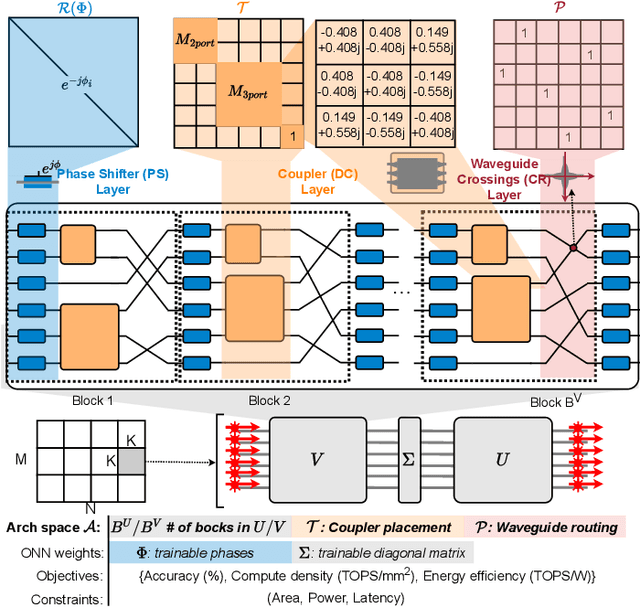
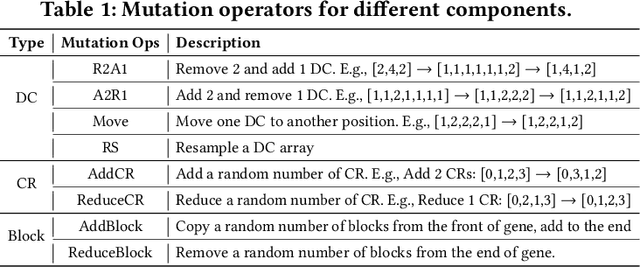
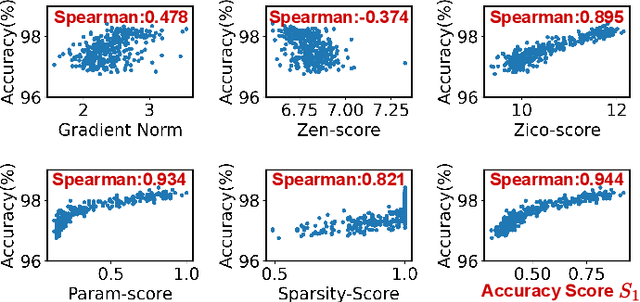

Abstract:Photonic tensor cores (PTCs) are essential building blocks for optical artificial intelligence (AI) accelerators based on programmable photonic integrated circuits. Most PTC designs today are manually constructed, with low design efficiency and unsatisfying solution quality. This makes it challenging to meet various hardware specifications and keep up with rapidly evolving AI applications. Prior work has explored gradient-based methods to learn a good PTC structure differentiably. However, it suffers from slow training speed and optimization difficulty when handling multiple non-differentiable objectives and constraints. Therefore, in this work, we propose a more flexible and efficient zero-shot multi-objective evolutionary topology search framework ADEPT-Z that explores Pareto-optimal PTC designs with advanced devices in a larger search space. Multiple objectives can be co-optimized while honoring complicated hardware constraints. With only <3 hours of search, we can obtain tens of diverse Pareto-optimal solutions, 100x faster than the prior gradient-based method, outperforming prior manual designs with 2x higher accuracy weighted area-energy efficiency. The code of ADEPT-Z is available at https://github.com/ScopeX-ASU/ADEPT-Z.
WaSt-3D: Wasserstein-2 Distance for Scene-to-Scene Stylization on 3D Gaussians
Sep 26, 2024



Abstract:While style transfer techniques have been well-developed for 2D image stylization, the extension of these methods to 3D scenes remains relatively unexplored. Existing approaches demonstrate proficiency in transferring colors and textures but often struggle with replicating the geometry of the scenes. In our work, we leverage an explicit Gaussian Splatting (GS) representation and directly match the distributions of Gaussians between style and content scenes using the Earth Mover's Distance (EMD). By employing the entropy-regularized Wasserstein-2 distance, we ensure that the transformation maintains spatial smoothness. Additionally, we decompose the scene stylization problem into smaller chunks to enhance efficiency. This paradigm shift reframes stylization from a pure generative process driven by latent space losses to an explicit matching of distributions between two Gaussian representations. Our method achieves high-resolution 3D stylization by faithfully transferring details from 3D style scenes onto the content scene. Furthermore, WaSt-3D consistently delivers results across diverse content and style scenes without necessitating any training, as it relies solely on optimization-based techniques. See our project page for additional results and source code: $\href{https://compvis.github.io/wast3d/}{https://compvis.github.io/wast3d/}$.
KAN 2.0: Kolmogorov-Arnold Networks Meet Science
Aug 19, 2024Abstract:A major challenge of AI + Science lies in their inherent incompatibility: today's AI is primarily based on connectionism, while science depends on symbolism. To bridge the two worlds, we propose a framework to seamlessly synergize Kolmogorov-Arnold Networks (KANs) and science. The framework highlights KANs' usage for three aspects of scientific discovery: identifying relevant features, revealing modular structures, and discovering symbolic formulas. The synergy is bidirectional: science to KAN (incorporating scientific knowledge into KANs), and KAN to science (extracting scientific insights from KANs). We highlight major new functionalities in the pykan package: (1) MultKAN: KANs with multiplication nodes. (2) kanpiler: a KAN compiler that compiles symbolic formulas into KANs. (3) tree converter: convert KANs (or any neural networks) to tree graphs. Based on these tools, we demonstrate KANs' capability to discover various types of physical laws, including conserved quantities, Lagrangians, symmetries, and constitutive laws.
Diffusion Models and Representation Learning: A Survey
Jun 30, 2024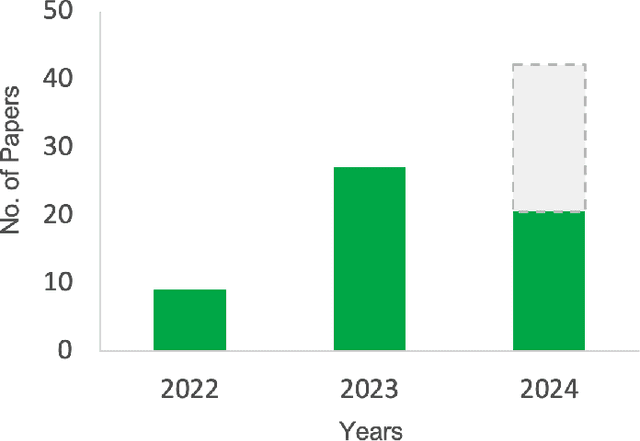

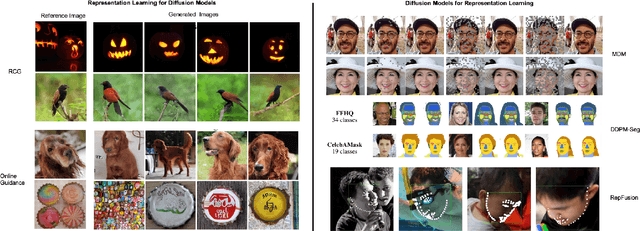
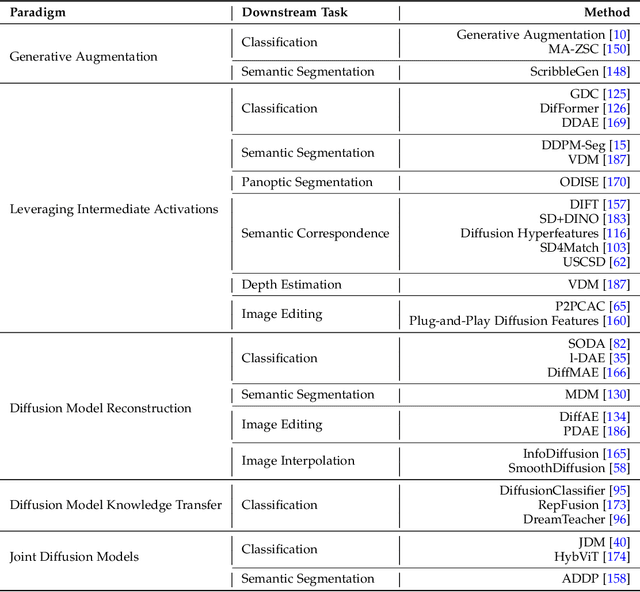
Abstract:Diffusion Models are popular generative modeling methods in various vision tasks, attracting significant attention. They can be considered a unique instance of self-supervised learning methods due to their independence from label annotation. This survey explores the interplay between diffusion models and representation learning. It provides an overview of diffusion models' essential aspects, including mathematical foundations, popular denoising network architectures, and guidance methods. Various approaches related to diffusion models and representation learning are detailed. These include frameworks that leverage representations learned from pre-trained diffusion models for subsequent recognition tasks and methods that utilize advancements in representation and self-supervised learning to enhance diffusion models. This survey aims to offer a comprehensive overview of the taxonomy between diffusion models and representation learning, identifying key areas of existing concerns and potential exploration. Github link: https://github.com/dongzhuoyao/Diffusion-Representation-Learning-Survey-Taxonomy
Dynamic Data Pruning for Automatic Speech Recognition
Jun 26, 2024Abstract:The recent success of Automatic Speech Recognition (ASR) is largely attributed to the ever-growing amount of training data. However, this trend has made model training prohibitively costly and imposed computational demands. While data pruning has been proposed to mitigate this issue by identifying a small subset of relevant data, its application in ASR has been barely explored, and existing works often entail significant overhead to achieve meaningful results. To fill this gap, this paper presents the first investigation of dynamic data pruning for ASR, finding that we can reach the full-data performance by dynamically selecting 70% of data. Furthermore, we introduce Dynamic Data Pruning for ASR (DDP-ASR), which offers several fine-grained pruning granularities specifically tailored for speech-related datasets, going beyond the conventional pruning of entire time sequences. Our intensive experiments show that DDP-ASR can save up to 1.6x training time with negligible performance loss.
 Add to Chrome
Add to Chrome Add to Firefox
Add to Firefox Add to Edge
Add to Edge